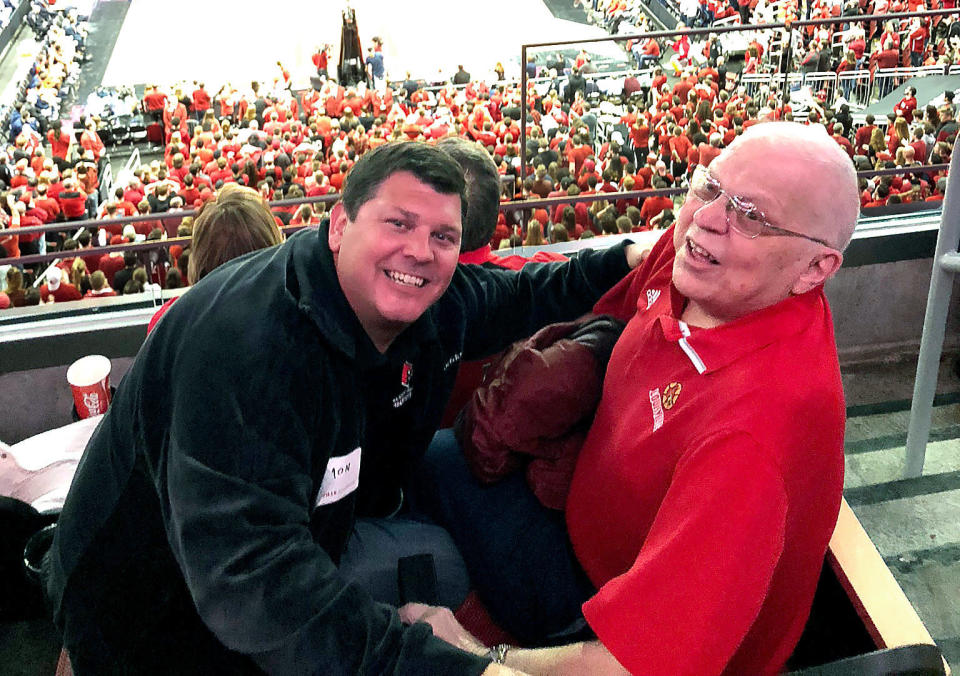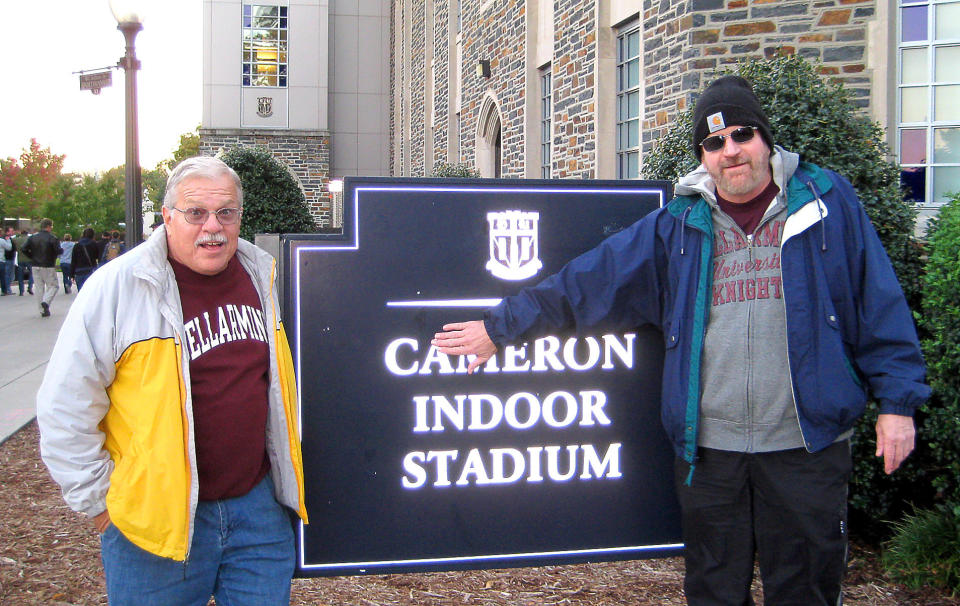Did Bob Stinson create the first NCAA tournament bracket pool?
Bob and Debby Stinson were an active couple in 1970s Louisville, regularly participating on co-ed softball and volleyball teams in the area. Each season would end with a single-elimination tournament laid out bracket-style. It was from one of those rec league sheets that Bob Stinson — a man who grew up in the shadow of Churchill Downs and always enjoyed a small wager — came up with an idea that seems so glaringly obvious now but qualified as an indelible stroke of genius for 1978.
“He looked at the brackets and said, ‘I can do this for college basketball and we can bet on it and the winner can take the jackpot,’ ” Debby Stinson remembers.
What did she think of the idea? “I thought it was great,” she says. “I love jackpots.”
[Best bracket wins $1M: Enter our free contest now! | Printable bracket]
When they got back home, Bob Stinson sat down at the kitchen table with a ruler and a sheet of paper and went to work placing all 32 teams in the 1978 NCAA tournament into his carefully drawn bracket. He wrote up rules and devised a points system. When he was done, he made copies and started passing them out to friends and family. Fifteen people entered that first pool for the princely sum of $1 per sheet.

No one can quite remember who won the first edition, but it was a rough first time out for the pool’s creator. Stinson picked defending champ Marquette to repeat, but the Warriors were upset in the first round by Miami of Ohio. Kentucky, the biggest rival of his beloved Louisville, ended up winning the whole thing.
Still, Stinson, who died at 68 last fall after a long battle with prostate cancer, felt like he’d discovered something big. And maybe even invented the modern-day March Madness pool in the process.
“He was always proud of making that claim,” Debby Stinson says with a chuckle.
It’s a bold claim, one that he first made in 1997 and has gone unchallenged since.
There’s just one question: Is it true?
Who invented the March Madness pool?
Filling out a blank bracket has become so elemental to March that it seems like the tradition has always existed. Suggesting that someone came up with the idea to do it first seems like suggesting someone was the first to eat chicken wings or hate Duke.
Yet there are two things impossible to ignore here:
Someone had to run the first pool.
Like picking a perfect bracket, it’s darn near impossible to figure out who that person was.
Do a bit of research and you’ll find that two different sources have been credited for the birth of the bracket pool.
The first and most widely cited ground zero is a bar in Staten Island named Jody’s Club Forest. As the legend goes, proprietor Jody Haggerty started the contest “around 1978.” The contest among patrons grew into a much bigger phenomenon, with the purse reaching a reported $1.5 million in the early 2000s. The contest eventually met its demise in 2006 when the IRS stepped in to see where its take had been going.
The Jody’s Club Forest pool, however, was not a traditional bracket pool in the truest sense. Haggerty only asked entrants to correctly pick the Final Four and overall champion (with the final score of the championship game as a tiebreaker) instead of all the games in the tournament.
The second source is Stinson, who believed he might have had something to do with the contest showing up in Staten Island.
Stinson worked for the U.S. Postal Service and traveled extensively at the time. He’d show up to different offices on the East Coast with his photocopied brackets in tow.
College basketball wasn’t the religion in some of these places like it was back in Kentucky, and Larry Bird and Magic Johnson were still a year away from making the tournament a true national phenomenon.
Still, those sheets were received well.
“He took it to New York, he took it to Philadelphia, he spread it around,” says Damon Stinson, Bob’s son. “This was the late ‘70s and early ‘80s and people were like, ‘This is the coolest thing ever.’ ”
While there’s no way to verify Stinson’s tie to Jody’s Club Forest — Haggerty died in 2016 — the spread of Stinson’s pool back home is a little easier to trace.
Each year, more and more family and friends would join what Debby called “Bob’s Jackpot.” Eventually, the Louisville Courier-Journal started printing its own bracket in the paper, which Stinson loved because it meant he could put away his ruler and paper.
Running the pool did not get much easier, though. While the prize amount never grew big enough to attract the attention of the IRS (entry fees never went much higher than $5), more and more loved ones wanted in on the fun. Stinson, who helped the USPS integrate computers into its offices and sorting systems, responded by designing a spreadsheet to keep track of entries — first on Lotus 1-2-3, then later on Microsoft Excel.
Tracking bracket entries electronically would soon become big business for places like Yahoo Sports, ESPN and even ncaa.com.
“I remember being a kid and being like, ‘Why can’t we take this out of the paper and fill it out like we always do it?’ Now I have to sit down and fill it out at the computer?” Damon Stinson said.
“But Dad was doing what everybody was doing before everybody was doing it. He had it all figured out.”

A claim that has gone unchallenged
As NCAA tournament pools began to grow bigger and bigger, Stinson began to wonder if he was truly the first to organize one. So in 1997 he sent an overnight letter to Bob Hill, a columnist with the Louisville Courier-Journal, laying out his case.
Stinson figured that if someone else had done one earlier than 1978, Hill would soon hear about it.
Hill figured the same.
“Somebody is sure to call with the claim that he or she invented the NCAA Office Pool in 1939 – the first year of the tournament,” Hill wrote. “But at least we now have a starting place, a legitimate nominee for Office Pool Hall of Fame – even if only in the Postal Service Division.”
Hill wrote the column 22 years ago and still remembers receiving the letter from Stinson, even if he can’t remember the details. He said he never heard from anyone disputing Stinson’s version of events.
“At one point, I think he just wanted some vindication on it,” Damon Stinson says when asked why his dad wrote the letter to Hill. “My dad felt like if he made the claim that someday someone would claim against him, but it never happened.”
Bob Stinson eventually lost interest in running his pools in the early 2000s. He was a man of many hobbies — he wrote novels and poems, won wood-turning competitions and loved being outdoors and coaching youth sports — and there were other things vying for his attention.
“Once it got big on the internet, he really kind of stopped doing it at that point. It just ruined it for him,” Damon Stinson says. “It was his thing for the longest time and once it got out of his reach, he just kind of let it go.”
Why the first pool was most likely in the late ‘70s
Even if Bob Stinson wasn’t the first to organize a bracket pool, the yet-to-come-forward suspect was likely only a year or two ahead of him.
Though the NCAA tournament was first held in 1939, a number of factors made the mid-to-late ‘70s a prime spot for the idea to germinate.
The NCAA tournament increased in popularity: When it was first established, the NCAA played second fiddle to the NIT, which was held in Madison Square Garden. It’s likely no one was lining up to wager on a regional sport played on a handful of college campuses. Additionally, only one team per conference was allowed to make the NCAA tourney until 1975, limiting the amount of interest in each geographical area.
The fall of UCLA: John Wooden’s Bruins won 10 of 12 national titles from 1964-75, making the prognostication game a lot less entertaining.
The rise of photocopiers and office culture: Imagine running a pool without a way to duplicate entry forms or an easy way to recruit participants. (It still took magazines and newspapers awhile to catch onto the trend and make it easy for readers to copy their pages. The first bracket didn’t appear in Sports Illustrated until 1983, smack dab in the middle of an ad for Camel cigarettes.)
A consistent number of teams: From 1953 to 1974, the NCAA tournament featured anywhere from 22-25 teams with seven to 10 byes, making for a convoluted bracket. The field stayed steady at 32 from 1975 to ‘78 before getting a bit crazy in the early ‘80s (between 48 and 53 teams with 16 byes) and finally settling into a symmetrical 64-team field from 1985-2000.
While those four areas would’ve greased the skids for Stinson or someone else, consistent coverage of the tournament on ESPN and CBS, however, didn’t start until 1982, making it logical that the first pool would spring up in an area that was well acquainted with college basketball and its leading teams.
With its two powerful programs, Kentucky would have certainly fit that bill.
Stinson’s name lives on
This is the first March the Stinson family is having without Bob and they say it’s been a rough one. Bob loved rooting on Louisville as well as his alma mater Bellarmine, a Division II program that won the national title in 2011.
“He was so avid about it and we watched all the games together,” Debby Stinson said. “Now I’m a little disheartened.”
The Stinsons say they’re OK if someone sees this article and says they were running a bracket pool before 1978 because Bob would have been OK with it.
They were overjoyed, however, when Yahoo Sports contacted them. Not only would this story keep Bob’s memory alive, but it’d allow them to help fulfill a promise that Bob made them make to raise awareness for prostate cancer.
The disease is much easier to fight with early detection, something that Bob did not benefit from. He fought a long five-year battle, opting for as many trials and experimental treatments as he could.
He died on September 20, 2018, but not before penning his own lengthy and accomplished obituary that never even mentioned his role in possibly inventing the bracket pool.
“He didn’t want to die,” says Damon Stinson. “He was mad that he got it. He hated that he got it.
“My dad always said at the end, whatever you can do to get the word out, spread the awareness. Because if people get screened, they won’t have to go through what I’m going through.”
So maybe Bob Stinson is the father of the March Madness bracket pool. Or maybe he isn’t.
Either way, if he’s the starting point for a talk about prostate cancer screenings, Debby Stinson would consider it a bigger jackpot than Bob could have ever arranged.
Did you start a NCAA bracket pool in the ‘70s or earlier? Email Kevin Kaduk and we’ll compile the earliest efforts in a future article.
More NCAA tournament coverage on Yahoo Sports:


